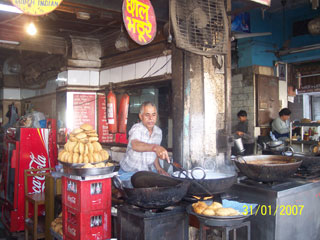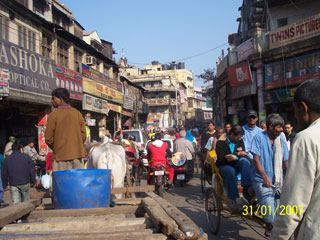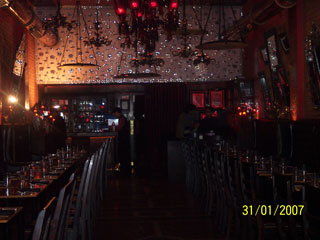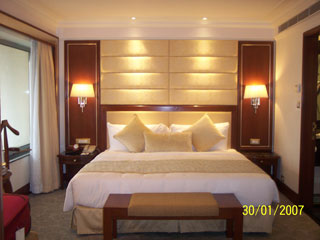
I am not sure that I would eat the food in Chandni Chowk, but I know Americans who have and survived.
They follow the rule: If it is fried, it is fine.
The shops are tiny, but they offer all kinds of small delights.
There is fresh paneer that will make its way to the city’s top hotels by noon.
There are countless dry-fruit stalls selling mounds of almonds, pistachios, walnuts, figs, and dates.
Delhi homes serve these on winter afternoons, salted and fried in a little ghee as an accompaniment to piping hot tea. There are chikkis (peanut brittles), made by crushing and stirring peanuts in caramelized sugar.
My husband is addicted to these, so I bought a bag.
There are shops boiling milk in large vats till it reduces to almost a quarter its volume. This condensed milk is the stuff of Indian kheers (hot milk puddings).
There was an old man frying puri (shown here), which truck drivers gulp down with hot potato saag and glasses of freshly churned lassi(buttermilk).
Even if you don’t eat a bite, you’ll be happy to spend hours just roaming around Chandni Chowk, taking in the sights and sounds and wonderful smells.
I wouldn’t miss it.
A cool, calm, and mostly Italian Diva.
Everyone in Delhi has an opinion about Veda, and most of them are bad.
Established by Chef Suvir Saran, who also runs Devi in New York, everyone agrees, scores high on decor. It looks like an Indian boudoir.
But the food, and the prices? Delhi matrons throw up their hands in disgust.
I went to Veda with low expectations, and consequently, I was pleasantly surprised.
The food is modern Indian, tasty and, best of all, light. No Mughlaisauces, no smothering of spices, no fiery chiles that beat the daylights out of your tongue.
Service was sympathetic. After I ordered several dishes, my waiter said: “That’s too much. Take out the mushroom dish; it’s not in season anyway.”
I would go back.
And then there’s Diva (think Italian this time), which is located in the popular M Block market, where you can shop for everything from bejeweled shoes to shawls. The cool, minimalist confines of Diva are refreshing after the chaos and cacophony outside.
I found the food a trifle too salty, but that may be because Indians prefer it that way. Risottos, pastas, soups, and breads are the staples here.
Delhi is a meat-lovers’ city, and Bukhara restaurant, therefore, is a shrine. J. P. Singh and the 16 chefs who work under him marinate and cure meats and chicken all day to be served for dinner.
No wonder Bill Clinton ate four meals in a row at this restaurant.
His daughter, however, has the dubious distinction of having a vegetarian dish named after her: the Chelsea Platter.
There are some hotels that I just don’t get. Claridge’s in London is one, Raffles in Singapore is another, and the Imperial in Delhi is a third.
I just don’t see what the fuss is all about.
The Imperial is one of those Delhi hotels that everyone loves, including my husband.
All my friends told me that I must stay there. But frankly, I was a little underwhelmed. The service was polite but just that. Nobody extended themselves.
When I asked the receptionist for some Scotch tape, she told me to walk across to the bell desk for some.
A gentleman beside me was arguing with the receptionist, who had just informed him that he could use the house phone to contact a guest. “Why can’t you just ring the room for me?’ the gentleman asked.
My room was a standard room with all the right trimmings—Porthault linens, Fragonard toiletries, reasonable size, forgettable decor.
The food was decent but nothing I would rave about, like I would rave about Bukhara at the Maurya Sheraton or Masala Art at the Taj Palace, the other top choices in Delhi.
A room at Delhi’s new Shangri-La Hotel.
But—and here is where I see my husband’s point of view—the Imperial has something which fewer and fewer hotels have these days: character. Not so much in its rooms, but in the public areas. The hotel has a wonderful collection of British prints about India. I happily spent an hour walking around the main lobby peering at these works, which often show prim English ladies having tea. One 18th-century piece by Tipu Sultan shows this Indian warrior-artist offering his two children as hostages to some British lord. There are walls filled with swords and other war memorabilia, along with archival photos. Character, history, call it what you will, but it is something that you cannot fake. Around the corner from the Imperial is the Shangri-La, the new kid on the block. The Shangri-La has no history or character, but my room was sleek and comfortable, and the service is ever-smiling and gracious. The breakfast buffet is the best in town. Make sure you ask for dosas. They aren’t displayed, but the chef will make them on order. Too bad I didn’t know this before I ordered. After a full breakfast, I longingly watched waiters bear crispy golden dosas to the nearby table. They looked really good, especially laced with some tomato or coconut chutney and sambar. The Shangri-La offers great views of the boulevards of Delhi, and on a clear day, you can even see India Gate at a distance. I would stay there again.

For some reason, well-meaning Delhi-ites always try to dissuade you from visiting Chandni Chowk.
I don’t think it is because they are ashamed of this old, crowded part of Delhi. Rather, they only see the logistical hassles involved.
It is like New Yorkers dissuading tourists from driving to the Hamptons on Friday evening. You know it will be great once you get there, but you also know what a hassle it will be to get there.
For the record, Chandni Chowk is a must-see. Don’t listen to the concierges, tour guides, friends, and well-wishers who tell you to “postpone it to the next trip when you have more time.”
That said, there is a way to do Chandni Chowk. Leave early—but not too early, or the shops won’t be open.
The spanking new Delhi Metro will whiz you over to the area in a few minutes from Connaught Place in Central Delhi, if you go before 10 a.m.
The same trip an hour later would take an hour. I got off the Metro near Red Fort. No car will enter Chandni Chowk unless it belongs there. The lanes are too narrow.
My driver fixed a rickshaw for me (like a tuk-tuk and just as wobbly) for a grand sum of $1.50. I ended up tipping the man almost double, mostly because he didn’t ask for a tip.
And then I sat back, got my camera out, and prayed.
The streets are very narrow, and rickshaws, countless pedestrians, and cows all jostle to get through.
There is an informal clicking noise that the wallahs (drivers) make with their tongue. It signals their impatience with the stalled traffic and works as well as a horn. But I forgot all this at the wondrous sights around me.
In Chandni Chowk, I saw the Delhi that I had read about in history books. The Delhi unvarnished by the modernity that India is racing to embrace.
India’s Supreme Court banned hawkers from cooking food on the street last week.
The wags and mandarins in the government seat of New Delhi are also considering the closure of all street-food stalls in Delhi proper in preparation for the 2010 Commonwealth Game. (They don’t want foreigners to get the proverbial Delhi Belly.)
But as with all things in India, “considering” is the operative word.
Even though all of us who live here complain about clogged traffic and clogged bureaucracies, it is part of the charm of this colorful messy democracy.
No doubt, there will be protests from the street-hawkers about how the government is taking away their livelihood.
Some leftist group will stage a walk-out from Parliament House and accuse the government of being elitist.
Talk-show hosts will wax eloquent about how the wonderful aloo-paratha (potato stuffed flatbread) that they enjoyed with their girlfriend in the Chandni Chowk market will be a thing of the past.
Delhi-ites will be polled for their views; there will be impassioned editorials in newspapers about how the short-sighted government is compromising the flavor of Old Delhi for a sanitized New Delhi.
My bet is that the centuries-old gulley-wallahs (stalls) will stay albeit, like the fake-handbag vendors in New York’s Chinatown, out of sight when the police vans rumble around. But they’ll be set up in full sartorial display the rest of the time.
[/et_pb_text][/et_pb_column][/et_pb_row][/et_pb_section]







Leave A Comment